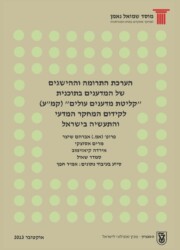During the past two decades, thousands of immigrant scientists have been employed in academic institutes in Israel, within the framework of various absorption programs (Shapira, Giladi and Kamea). The Ministry of Absorption, through it unit of Absorption in Science, allocated most of the funds for these programs that were supplemented by inner- and outer-university sources. The present study is focused on the group of the senior scientists, the Kamea scientists. Data for this group has been gathered and analyzed with a view to quantify and present their contributions and impact on various aspects of research, teaching and a variety of activities relevant to academic research and to industry. Data has been mined from all universities and other institutes that have employed the Kamea scientists.
The purpose of the study was to evaluate the contributions and achievements of the immigrant scientists participating in the Kamea program. The program was designed to ensure job security to outstanding senior scientists until they reach retirement age, by appointing them to research positions in research institutes.
Among the topics to be included are: statistics (present and past numbers, education, areas of expertise, gender, age, tenure in academic frameworks (including other absorption programs), sectioning among universities, etc.), budgets, participation in research, publications of articles and books, development of teaching and research laboratories, prizes won, initiation of hi-tech companies, contributions to industrial activities in Israel, and more.
The study relates to the financial aspects of the program, which was initiated in 1998 by the Israeli government in order to continue absorbing from among the senior level immigrant scientists in universities, colleges and research institutions. The purpose of the program is to enable the extended absorption of immigrant scientists who have completed the Giladi program. Most of the program participants are employed in research groups in higher education institutions and some in research institutes or hospitals. The institutions employing the scientists usually undertake to employ them until pensioned retirement. In the first stage, their employment is guaranteed for three years. Other objectives include upgrading their academic status as researchers to levels and salaries that are in line with those of senior faculty members at the same institution, and the accumulation of resources to be used in due course for their pension payments.
The program was funded by the Ministry of Immigrant Absorption through the Center for Absorption in Science in collaboration with the Planning and Budgeting Committee of the Council of Higher Education and the employing institutes. The study sampled 338 of the 680 immigrant scientists who took part in the Kamea program starting in 1998 until the end of 2011. The overall cost of financing the Kamea program in these years is estimated at one and a half billion shekels. The average length of stay of scientists in the program was about nine years.


